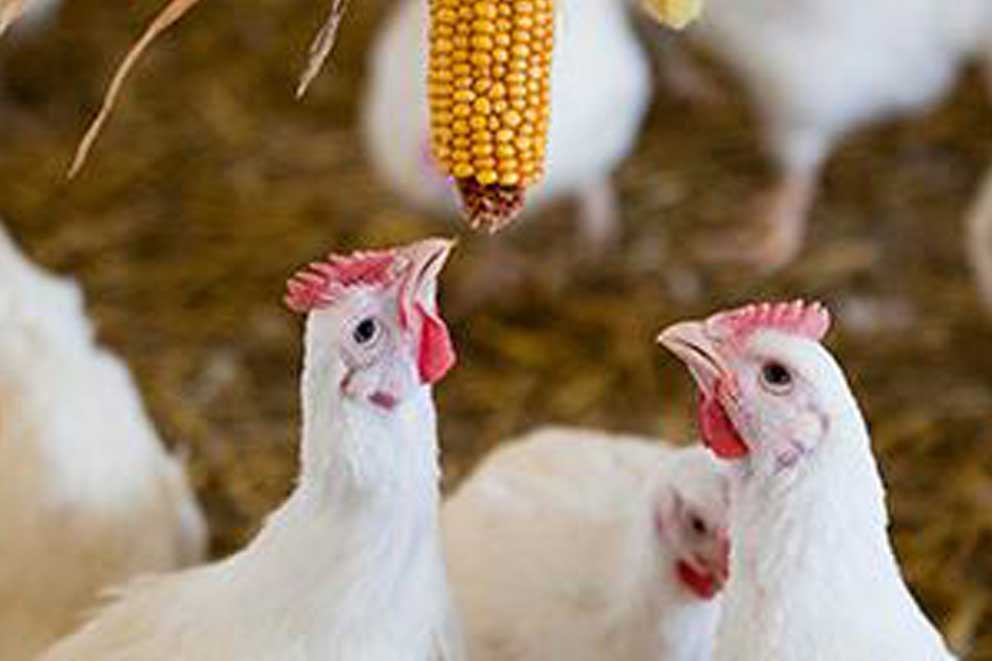Meat chicken behaviour
Meat chickens share many of the same behaviours as their wild ancestors, which include the following.
- Perching – chickens are strongly motivated to perch. In the wild, they perch in trees at night.
- Exploring – chickens like to explore their environment, for example by pecking at objects and scratching at the ground.
- Dustbathing – dustbathing helps chickens remove parasites and keep their skin and feathers in good condition. They can use a suitable dry material (such as wood shavings, sand or fine soil) to bathe in.
- Grooming – this includes preening and feather ruffling.
- Activity – chickens can run and wing flap and may 'spar' (play fight) with each other to establish their dominance.
We believe that all chickens should be kept in environments where they're able to do these important things.
did you know?
- Chickens can count: They’re intelligent creatures with basic maths skills, able to count, calculate simple sums and even solve puzzles (so don’t count your chickens – or else they may count you.)
- Chickens can recognise faces: As social animals, chickens can recall people they’ve seen before, recognising up to 100 faces! They also identify other chickens based on their individual features.
- Chickens feel deeply: From extreme happiness (when they close their eyes and purr!), to empathy for other chickens – chickens are sensitive animals. This means, when they’re caged in small spaces with limited movement, they also suffer physically and emotionally.
- Chickens have their own language: They make around 30 different calls to communicate with each other.
- Chickens can see more colours than us: Hens have colour vision and can see red, green and blue light – however, like many other birds they can also see ultraviolet light, which means they see more colours and shade than humans.
Farming meat chickens
In 2022, 1.1 billion meat chickens were slaughtered in the UK¹. Meat chickens can be reared in several different production systems. Here's more about how they're reared for meat in the UK.
Chicken meat production systems
Indoor reared
Most meat chickens are reared in large, closed buildings, where temperature, artificial lighting, ventilation and food and water are carefully controlled. They're given food and water in lines along the length of the building. Wood shavings cover the floor.
Typically, around 25,000 birds are housed together within a building, but some can house as many as 50,000 birds. There can be several buildings on a farm. Most birds are reared at a stocking density (amount of space per bird) of 38kg per square metre, which is around 19 x 2kg birds for each square metre of floor space.
Light levels can be kept low to encourage the birds to eat more and move around less, which maximises their growth rate.
Improved indoor reared
A smaller proportion of meat chickens are reared in indoor systems in conditions that improve their welfare. These are similar to those described above, but include improvements such as:
- fewer birds per square metre
- environmental enrichment, such as straw bales for the birds to peck at.
What's more, this system may use slower-growing breeds of chicken.
Free-range and organic
Meat chickens can also be reared in systems where they can access an additional outdoor area for part of their lives. The chickens can reach this area through 'popholes' in the side of the building.
The law requires free-range and organic systems to meet certain requirements, such as the amount of space in the building and the age of the birds at slaughter.
End of rearing
It usually takes five to six weeks for the birds to reach the desired weight for slaughter, which is around 2.2kg. They're then caught, put into crates and transported to the abattoir.
Meat chicken welfare issues
We're concerned about the welfare of meat chickens, particularly about fast growth rates and the lack of space, lighting and environmental enrichment.
Help millions of chickens a year – we're calling on supermarkets to sign up to The Better Chicken Commitment and commit to raising welfare standards across their whole supply chain of chicken.
Growth rate
Meat chickens have been genetically selected to grow very quickly. The time from when the birds hatch to reaching slaughter weight can be as little as five weeks. This rapid weight gain can cause severe health problems, such as lameness and heart defects.
We believe that only genetically slower-growing breeds should be used, as these are less likely to develop these welfare problems.
Space
Keeping chickens in overcrowded conditions lowers their level of wellbeing, as it stops them moving around and exercising properly. It can also be more difficult to maintain good quality air and litter (the material covering the floor). Overcrowding means that problems such as lameness and skin diseases can be much more common and it can be difficult for birds to perform many of their natural behaviours.
When the total bird weight within a square metre of floor space is higher than 30kg – such as 15 x 2kg birds – there's a higher risk of serious welfare problems developing. Many meat chickens are reared at a total bird weight of 38kg per square metre, such as 19 x 2kg birds.
Environmental enrichment
The majority of chickens don't have enough of the right environmental enrichment items to allow them to perform natural behaviours, such as perching and investigation.
A stimulating, enriched environment (for example, containing straw bales, perches and objects to peck at) encourages birds to be more active, helping to keep them healthy.
Lighting
Chickens only have to be provided with artificial light at a light level of 20 lux. In contrast, a brightly lit room is around 400 lux, and natural daylight is around 30,000 to 100,000 lux.
Chickens have well-developed colour vision. This is their main sense and is designed for brightly lit conditions. Daylight is required for chickens to use this sense to their full potential.




